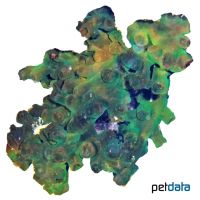Black Tube Coral (LPS) (Tubastraea micranthus)
| Black Tube Coral (LPS) Tubastraea micranthus | |
|---|---|
| Name | Black Tube Coral (LPS) |
| Name Lat. | Tubastraea micranthus |
| Family | Branched Corals |
| Family lat. | Dendrophylliidae |
| Order | Stony Corals |
| Order lat. | Scleractinia |
| Origin | Indo-Pacific |
| Diet | Planktivore |
| pH | 8.1-8.4 |
| Hardness | 8-10 °KH |
| Lighting | Low |
| Current | Strong |
| Behavior | Peaceful |
| Keeping | Colony |
| Care Level | Moderate |
| Life Span | N/A |
| Protection | CITES Appendix II; EC Annex B |
| Metric Units | |
| Size | 3-5 cm |
| Temperature | 24-27 °C |
| Salinity | 33-36 ‰ |
| Aquarium | 200 l |
| US Units | |
| Size | 1-2" |
| Temperature | 75-81 °F |
| Salinity | 1.020-1.025 sg |
| Aquarium | 50 gal |
Distribution and habitat
Tubastraea micranthus belong to the group of LPS (Large Polyp Scleractinia). These non-reef-building corals (ahermatypic) are widely distributed in the tropical Indian and Pacific Oceans. They occur in colonies up to 40 cm in size, mostly under rock overhangs in the lower intertidal zone.
Maintenance
They should be positioned in a place on the bottom with the lowest possible light intensity and strong, alternating current. Only lime-rich, heavy metal-free substrates may be used as substrate
Filters, skimmers and heaters are necessary to ensure water quality, as well as pumps to simulate tides, swells and bottom currents. It is recommended that live stones be used to set up the aquarium. The bacteria living in the porous stones act as a biological filter. The lighting must correspond to the species-appropriate day-night rhythm of the animals
| Salinity: 33-36 ‰ | pH value: 8.1-8.4 |
| Carbonate hardness: 8-10 °KH | Nitrate content: 2-8 mg/l |
| calcium content: 420-450 mg/l | Nitrite content: 0.0-0.05 mg/l |
| Magnesium content: 1.250-1.350 mg/l | phosphate content: 0.01-0.1 mg/l |
Regular addition of trace elements, especially calcium and strontium, is recommended. For salinity, an average value should be aimed for, which may only vary slightly by +/- 0.5 ‰. Ammonia and ammonium must not be measurable. Special attention shall be paid to consistently good water quality and water values.
Diet
No zooxanthellae (azooxanthellate) live in their tissue. Therefore, in addition to the food produced in the aquarium during fish feeding (mysis, krill, Artemia, floating shrimp, etc.), they are regularly dependent on supplementary food, such as Artemia nauplii enriched with vitamins and commercially available phyto- and zooplankton
Regular and varied feeding promotes health and prevents deficiency symptoms.
Behaviour and compatibility
They should not be kept with fish that regard their polyps as food (e.g. angelfish or butterflyfish). They are well tolerated with other corals, but sufficient distance from cnidarians must be maintained. They are sensitive to touch.
Reproduction and breeding
The reproduction takes place via the formation of daughter colonies (breeders). In the aquarium, reproduction by fragmentation has occasionally already succeeded.
Species protection
Species protection: WA Appendix II; EU Appendix B. The proof of purchase is the required proof of origin for the animal. Please keep it safe! Your pet store will be happy to provide you with further information.
Important
They belong to the group of azooxanthellate corals and can therefore colonize biotopes without sunlight. They should be anchored upside down in the reef, because sediment deposits can kill the corallites.
A calcium reactor and magnesium metering pump are recommended for the necessary steady supply of calcium carbonate and magnesium. Too high temperature, insufficient lighting or current as well as sudden change of water values can lead to tissue decay (RTN - rapid tissue necrosis). When purchasing, look for pressure marks or other tissue damage. If different species are kept together, make sure that fish and invertebrates match each other in terms of water quality and temperature requirements and social behavior, and that the setup meets the ecological needs of all species kept together. Newly introduced animals must be acclimated slowly to the water in the aquarium
Further literature can be found in your pet store.
References
Text: Christian Sänger; Image: petdata
Source: FOSSÁ & NILSEN (1995): Korallenriff-Aquarium Bd. 4, Birgit Schmettkamp Verlag; ENGELMANN & LANGE (2011): Zootierhaltung - Tiere in menschlicher Obhut: Wirbellose, Verlag Harri Deutsch
